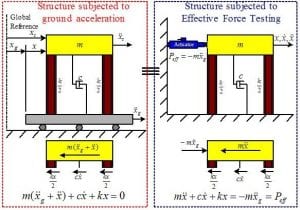|
Effective Force Testing: |
 |
|
|Home|Pilot study|Development|Validation|References|Site map|Contact us| |
| Principal Investigators: Catherine C. French Carol K. Shield Thomas A. PosberghSponsors: National Science FoundationGraduate Students: Matthew Spink Jian Zhao John Timm J. A. Murcek (J. Dimig) |
| The Description: |
|
Real-time dynamic testing is necessary for the study of seismic response of structures which exhibit velocity dependent behavior (e.g., structures incorporating active or passive control devices). Effective force testing (EFT) is a dynamic testing procedure to apply real-time earthquake loads to large-scale structures that can be simplified as lumped mass systems. In an EFT test, the test structure is anchored to a stationary base, and dynamic forces are applied by hydraulic actuators to the center of each story mass of the structure. The force to be imposed (effective force) is the product of the structural mass and the ground acceleration record, and thus is independent of the structural properties such as stiffness and damping, and their changes during the test. Motions measured relative to the ground are equivalent to the response that a structure can develop relative to a moving base as in a shake table test or an earthquake event. Early investigation of the EFT method indicated that in the direct implementation of EFT, the actuator was not able to apply forces accurately near the natural frequency of the test structure , which was attributed to the natural velocity feedback in the servo-hydraulic system (i.e., the interaction between the actuator piston velocity and the actuator control) identified by Dyke et al. in a study of active structural control. A standard Proportional-Integral-Derivative (PID) controller is unable to compensate for the pressure variation near resonance, thus causing force-tracking errors. Velocity feedback compensation can solve the problem and make the successful implementation of EFT possible. The compensation is made through modifying the command to the servovalve (i.e., a compensation signal was added to the servovalve command signal). The compensation algorithm is independent of the structural properties (i.e., damping and stiffness) and their changes during a test. EFT complements the currently available seismic testing methods: quasi-static cyclic studies of structural components, shake table testing, and pseudodynamic studies of large-scale structural systems. As the EFT method becomes available to researchers. The capabilities of existing lab facilities will be expanded to conducting real-time earthquake simulation of large size structures. |
| Research Program: |
|
| Publications and Presentations: |
Dimig, J. , Shield, C., French, C., Bailey, F., and Clark, A. (1999) “Effective Force Testing: A method of seismic simulation for structural testing.” Journal of Structural Engineering, American Society of Civil Engineers, Vol. 125, No. 9, pp. 1028-1037. (EFT_1999.pdf) Shield, C., French, C., Timm, J. (2001) “Development and implementation of the effective force testing method for seismic simulation of large-scale structures.” Philosophical Transaction of the Royal Society: Theme Issue on Dynamic Testing of Structures. A 359: 1911-1929. (EFT_2001.pdf) Zhao, J., French, C., Shield, C., and Posbergh, T. (2003) “Considerations for the development of real-time dynamic testing.” Earthquake Engineering and Structural Dynamics. Vol. 32, No. 11. pp. 1773-1794. (EFT_2003.pdf) Zhao, J., Shield, C., French, C., and Posbergh, T. “Nonlinear system modeling and velocity feedback compensation for EFT.” Journal of Engineering Mechanics ASCE 131(3), 244–253. (EFT_jem2005.pdf) Zhao, J., French, C., Shield, C., and Posbergh, T. “Testing a nonlinear structure using a shake table and the EFT method.” Journal of structural Engineering. (In print) (EFT_jse2006.pdf) Shield, C., Zhao, J., Spink, M., French, C., and Posbergh, T. “Effective Force Testing for Multi-Degree of Freedom Structures.” Proceedings of the Institution of Mechanical Engineers, Part I, Journal of Systems and Control Engineering. (Submitted)
French, C., Timm, J., and Shield, C. (2000) “Implementation of effective force testing: method of seismic simulation for structural testing.” 12th World Conference on Earthquake Engineering, Upper Hutt, New Zealand, Paper No. 1681. Zhao, J., French, C., Shield, C., and Posbergh, T. (2002). “Development of EFT for nonlinear SDOF systems.” 7th National Conference on Earthquake Engineering. Boston, MA. (EFT_7NCEE.pdf) Zhao, J., French, C., Shield, C., and Posbergh, T. (2004) “Effective Force Testing With Nonlinear Velocity Feedback Compensation.” 13th World Conference on Earthquake Engineering, Vanvouver, Canada. Paper No. 268. (EFT_13WCEE_a.pdf) Zhao, J., Shield, C., French, C., and Posbergh, T. (2004) “Effect Of Servovalve/Actuator Dynamics On Displacement Controlled Testing.” 13th World Conference on Earthquake Engineering, Vanvouver, Canada. Paper No. 267. (EFT_13WCEE_b.pdf)
Murcek, J. (1996) “Evaluation of the Effective Force testing Method Using a SDOF Model.” Master’s thesis. Department of Civil Engineering, University of Minnesota, Minneapolis. 171 pp. (Paper) Timm, J. (1999) “Natural Velocity Feedback Correction for Effective Force Testing.” Master’s thesis. Department of Civil Engineering, University of Minnesota, Minneapolis. 265 pp. (Paper) Spink M. (2002). “MDOF implementation of effective force testing: a method of seismic simulation.” Master’s thesis. Department of Civil Engineering, University of Minnesota, Minneapolis. Zhao, J. (2003) “Development of EFT for Nonlinear SDOF Systems.” Ph. D thesis. Department of Civil Engineering, University of Minnesota, Minneapolis. (EFT_zhao.pdf) |
|Home|Pilot study|Development|Validation|References|Site map|Contact us|
